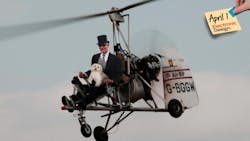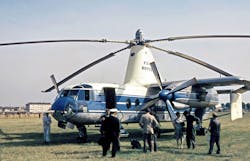Hybrid Hele-Kites Offer a Novel Approach to Wind Power
This article is part of the 2022 April 1st series in the Humor topic within our Series Library.
My latest assignment for Electronic Design took me to Blairstown Airport, a small unpaved strip located in the Middle of Nowhere, New Jersey, where I'd be having breakfast with Dr. Benissimo Frankolini, the CEO of alternative-energy startup Tethergy LLC.
We'd agreed to meet at Donna’s Runway Café, a tiny joint, seemingly stuck in the 1950s. It’s a favorite of the area's pilots who gladly fly 100 miles or more to enjoy a slice of their home-baked pie along with a view of the runway from every table. The pie and view were as good as promised. But, after 30 minutes elapsed beyond our appointed time, Frankolini still hadn't arrived.
I'd just finished my fourth cup of Donna's impressively strong coffee, when the café door flew open and the rumpled figure of the CEO, also Professor Emeritus at Princeton University, hurtled into the café, out of breath and practically stumbling into my outstretched handshake.
With Dr. Benissimo Frankolini and his co-pilot Pepper at the controls, Tethergy's first technology demonstrator proved that it’s possible to use a tethered gyrocopter as an aerial wind generator. (Image credit: NBC and Slate)
After the good doctor settled into our booth and ordered up a slice of mile-high coconut custard, he shared some of the details of his latest clean-tech venture:
ED: I'm glad you made it!
BF: Me too! We had a bit of a problem with one of the units, so I had to coordinate our ground crew with state police to go find it. But, Lee and I go back to his days at RCA Astro. We did some interesting work and got into some interesting mischief back then, including, among other things, Project I.R.A.! He's always been there for me when I needed him so I'm glad to return the favor!
ED: Glad you made it and thanks. So maybe you can tell me a little about yourself, and why we're here, besides the pies...
BF: Of course. My family emigrated to this area from Turin, Italy. This is pretty close to the house where I grew up, and where I'd spend time between semesters while I was studying for my Ph.D. in Physics at Princeton.
ED: Wait, you're old enough...
BF: Yes, Dr. Einstein was one of my profs. Everybody asksED: You changed oil on...?
BF: Of course not. So, tell me again, why did Goldberg send *you*?
ED: Sorry, it took me a sec. Ok, so you took glider lessons and had family in the area. Why are we here?
BF: My medical expired, but I'll take you up in my glider later, anyway, and let you experience why. In short, the unique geology of this area, namely the Kittatinny Ridge, gives us some unique and laminar wind currents that produce wave currents so powerful that they can lift a glider to 12,000 feet MSL. Some pretty thin air up there if you think about it.
ED: OK, but what's that have to do with alternative energy?
BF: Hmmm, I guess I have to spell it out for you. Look, there are two ways to get a glider into the air. One is being towed up by another plane, and the other is to use a winch with a very long tow cable. The ground-based winches accelerate the glider to flying speed while the glider executes a very steep climb to anywhere between 700 and 1,000 feet before releasing the cable. So about three years ago, while doing my preflight, it dawned on me: What if I climbed up to 1,000 feet during a tow, but didn't release the winch cable?
ED: You'd have an expensive kite...
BF: Correct. But there's tremendous energy at that altitude and above, so what if we winch-launched a small private aircraft, like a Cessna or a Piper, on a nice, windy, day? If there was enough wind, could we leave the engine off and keep it tethered?
ED: Ah, I see where you're going with this. The propeller would “windmill,” right?
BF: Correct. If we use the winch to get aloft, no engine is needed—and we can replace it with an electric generator.
ED: Ok, I see how you could generate some amount of electricity that way. But from my experience as a pilot, I don't think you can get a whole lot of power out of a windmilling prop.
BF: Of course not. If you compare the diameter of the propeller arc diameter to that of a modern wind turbine, say 200 to 300 feet, it's pretty clear that the prop doesn't produce much power.
ED:
BF:
ED: Like a helicopter?
BF: You're close, but we actually went with something simpler—a gyrocopter. You may have seen them in movies like Mad Max, or James Bond’s You Only Live Twice, that a “gyro” doesn’t power its rotor, but instead provides thrust by a separate propeller and the rotor turns and provides lift. We don't have a propeller; we have the wind waves coming over The Ridge, acting against the winch tether which, in this case, we didn't release. That turns the rotor, maintaining an altitude where winds are steady and fast. Besides providing the necessary lift, the rotor uses most of the energy it extracts from the airstream to drive an electrical generator.
ED: And you use the gyro's tether to send the electricity you generate to the ground?
BF: Correct.
ED: So, when do you expect to test your theory with a prototype?
BF: Actually, we did that a couple of years ago with a small technology demonstrator. The tests were so successful that we scaled up the design and have four, er, correction, three electrogyros in the air not far from here. Each one is soaking up the Kittatinny Ridge's steady updraft and turning it into a megawatt worth of clean energy.
Telethergy was able to bring its first four Mk.1 electrogyros on line within 18 months by retrofitting the airframes of existing Fairey Rtodynes with tethering hardware, a larger rotor, and a 1.2-MW generator. Until the retrofit, the 1950s-era British compound gyroplane was believed to be the largest passive rotor aircraft built to date. (Image credit: J Thinesen, SFF photo archive)
We actually have four machines, one of which just went down for maintenance this morning. The reason I was late was because the fourth gyro's diamond fiber tether snapped and it went into freeflight mode. Our engineering team thankfully anticipated this failure mode and installed an Arduino-based GPS autopilot that would land in a predetermined open field 20 miles uprange.
Anyway, I got the call around 5 am and it took us a while to secure the unit and get it ready for transport back to our hangar. I hope the delay didn't cause you too much inconvenience.
ED: Any idea as to why the tether snapped?
BF: It's too early to tell, but I suspect a manufacturing defect—likely a lattice dislocation—in the 5,000-foot-long monocrystalline diamond fiber tether. But we did check the date code on the cable assembly just before I got here. It’s 04-01-20.
ED: Sorry to hear that, I hope you get your fourth generator back in the air soon. But, whatever happens, please keep us posted on any further developments. And, for now, let's have another slice of that pie.
Read more articles in the 2022 April 1st series in the Humor topic within our Series Library.


